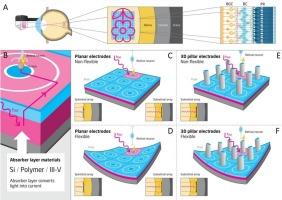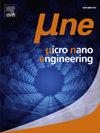Developments in the design and microfabrication of photovoltaic retinal implants
IF 3.1
Q2 ENGINEERING, ELECTRICAL & ELECTRONIC
引用次数: 0
Abstract
Photovoltaic retinal implants are emerging as a promising technological solution for restoring vision for patients suffering from retinal degenerative diseases such as retinitis pigmentosa and age-related macular degeneration. These prostheses contain arrays of miniaturized solar cells converting light into electrical output signals, which subsequently are employed for local activation of the intact neuroretina via microelectrodes. Leveraging cutting-edge microfabrication techniques, photovoltaic retinal implants are compact and provide a high density of solar cell pixels. This potentially increases the resolution of the artificial vision and the field of view and lowers the threshold for stimulation of retinal neurons. The introduction of flexible substrates and the integration of 3D electrodes has greatly improved the connection with retinal neurons, optimizing the spatial resolution and potentially lowering the stimulation threshold. This review explores the latest developments in photovoltaic retinal prostheses, highlighting key aspects of their design, fabrication and performance. This field of research is still in its early stage and particular emphasis is laid on promising future research directions including miniaturization of pixels, incorporation of organic flexible semiconductors and first studies considering 3D stimulating electrode structures. Despite the significant progress made, there are still substantial challenges to overcome, such as ensuring long-term biocompatibility and validation of the novel concepts in clinical trials. Ongoing interdisciplinary research and development are essential for moving these promising technologies from the lab to real-world clinical applications, ultimately enhancing vision restoration. This review aims to provide a comprehensive overview of the current state of photovoltaic retinal implants and pinpoints critical areas for future research to further advance this transformative technology.

光电视网膜植入物的设计和微加工进展
光生伏打视网膜植入物正在成为恢复视网膜变性疾病(如视网膜色素变性和老年性黄斑变性)患者视力的一种有前途的技术解决方案。这些假体包含微型太阳能电池阵列,可将光转换为电子输出信号,然后通过微电极局部激活完整的神经视网膜。利用尖端的微加工技术,光电视网膜假体结构紧凑,太阳能电池像素密度高。这有可能提高人工视觉的分辨率和视野,并降低刺激视网膜神经元的阈值。柔性基板的引入和三维电极的集成大大改善了与视网膜神经元的连接,优化了空间分辨率,并有可能降低刺激阈值。本综述探讨了光电视网膜假体的最新发展,重点介绍了其设计、制造和性能的关键方面。这一研究领域仍处于早期阶段,特别强调了未来大有可为的研究方向,包括像素的微型化、有机柔性半导体的融入以及首次考虑三维刺激电极结构的研究。尽管取得了重大进展,但仍有大量挑战需要克服,如确保长期生物兼容性和在临床试验中验证新概念。要将这些前景广阔的技术从实验室推向现实世界的临床应用,并最终促进视力恢复,持续的跨学科研究和开发至关重要。本综述旨在全面概述光伏视网膜植入物的现状,并指出未来研究的关键领域,以进一步推动这一变革性技术的发展。
本文章由计算机程序翻译,如有差异,请以英文原文为准。
求助全文
约1分钟内获得全文
求助全文
来源期刊

Micro and Nano Engineering
Engineering-Electrical and Electronic Engineering
CiteScore
3.30
自引率
0.00%
发文量
67
审稿时长
80 days
 求助内容:
求助内容: 应助结果提醒方式:
应助结果提醒方式:


